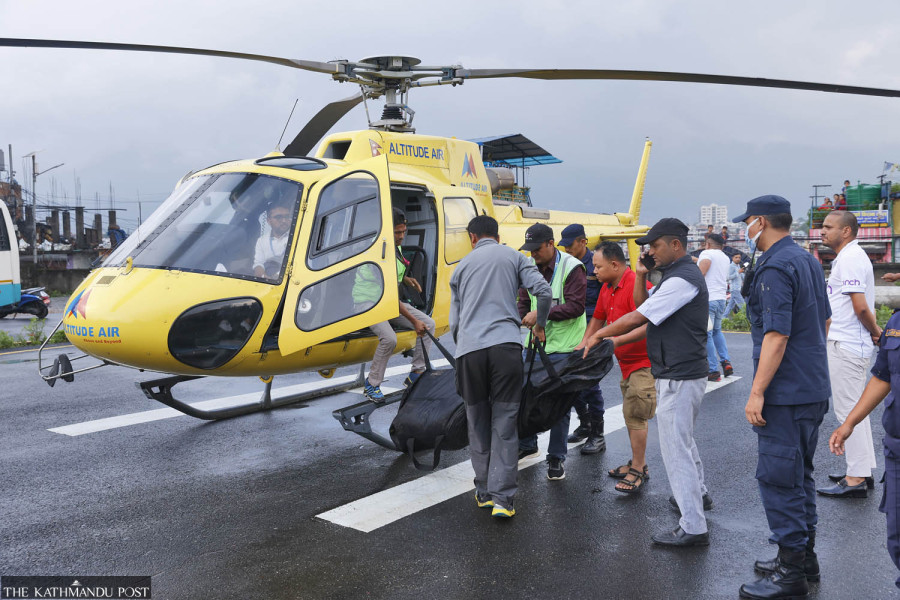National
Chopper sightseeing tour of 5 Mexicans ends in tragedy
All five passengers and the Nepali pilot were killed in a Manang Air crash caused most likely by poor visibility.
Sangam Prasain
It was a sunny morning on Tuesday when a Mexican family excitedly took off on a helicopter tour of Everest. They had seen many videos of the world's highest peak on YouTube, and wanted to go and see it by themselves.
So the father, mother, son and two daughters arrived in Nepal from Mexico, and booked a helicopter tour to the 8,848.86-metre giant.
“They were very excited to make a helicopter tour of the breathtaking Everest,” said Captain Prakash Kumar Sedhain, a flight safety director at Manang Air. “Unfortunately, it ended in disaster.”
The monsoon is not a good time for climbing expeditions to the Himalaya or trekking in the mountains. The weather is bad, the trekking routes slippery, so hiking is full of risks. But a few enthusiasts go on helicopters to get a close look at the soaring heights of rock and ice.
On Tuesday morning, the Mexican family fulfilled a long-held wish with a nearly hour-long tour of Everest with Manang Air. Their helicopter then made a stop at Surke, a mountain village south of Everest, to refuel for the return flight to Kathmandu.
Surke village, which lies at an altitude of 2,300 metres, is situated near the famed Lukla Airport which is the starting-off point for Everest expeditions.
At 10:05 am, the helicopter carrying the Mexican family took off from Surke for Kathmandu, and was lost immediately after. According to a statement issued by the Civil Aviation Authority of Nepal, the chopper made its last contact with Lukla Airport tower at 10:13 am.
It took rescuers five hours to locate the site where the craft had gone down, killing all on board. The Manang Air helicopter bearing registration number 9N-AMV had slammed into a hillside at Lamjura.
The crash site lies at an elevation of about 3,500 metres in Likhupike Rural Municipality of Solukhumbu district. At 5.30 pm, all six bodies were airlifted to Kathmandu for postmortem.
The five Mexican passengers and Captain Chet Bahadur Gurung, who was flying the helicopter, were killed, said Dipak Kumar Shrestha, Deputy Superintendent of Police at the Solukhumbu District Police Office.
“The weather was not good. It was raining heavily at the site where the chopper had crashed. It looks like the accident was caused by bad weather.”
Prime Minister Pushpa Kamal Dahal has expressed sorrow over the crash.
The exact reason behind the catastrophe is not known, and a government fact-finding commission is to launch a detailed investigation. A Cabinet meeting on Tuesday evening announced an investigation commission led by Buddhi Sagar Lamichhane, joint secretary at the Ministry of Tourism.

The helicopter, a Eurocopter AS350 Écureuil, now designated Airbus Helicopters H125, was manufactured in France.
Preliminary reports show that the nature of the crash was controlled flight into terrain (CFIT). This means that an airworthy aircraft, under complete control of the pilot, unintentionally hits the ground. The pilots are generally unaware of the danger until it is too late.
“The helicopter initially hit the top of a tree and then hit the sloppy ridge with a huge impact between two passes in a dense forest,” said Sedhain of Manang Air.
The crash site lies southwest of Phaplu Airport.
“In the monsoon, we cannot predict the weather. There are fast-moving clouds all over,” said Sedhain. “My preliminary observation is that the pilot manoeuvred the chopper trying to dodge the cloud patches. He, however, was unsuccessful.”
Raju Neupane, operation and safety manager of Manang Air, said the last location of the chopper was tracked at 10:12 am in the Lamjura Pass area.
“We immediately mobilised an Altitude Air chopper. Security officials, too, moved into the area.”
The Manang Air helicopter crash at Lamjura is the third fatal air disaster in Nepal in 13 months.
On May 29, 2022, Tara Air Flight 197 crashed in Jomsom, killing all 22 people on board.
Seven months later, on January 15, Yeti Airlines Flight 691 from Kathmandu crashed while attempting to land at the new international airport in Pokhara, killing all 72 persons on board. This was the deadliest accident involving an ATR 72.
Helicopters in Nepal typically operate in challenging topography, and the flights operating during inclement weather are particularly at risk.
At least 20 fatal helicopter crashes have taken place across the country since the aviation authority started keeping records in 1966.
The latest crash involved a Simrik Air flight which crashed in Sankhuwasabha in May, killing one.
Tuesday’s accident comes as another blow to the country’s flight safety record when the government has been attempting—with great difficulty—to introduce safety reforms at the Civil Aviation Authority of Nepal.
Industry insiders say that frequent air crashes have dented Nepal’s image as a tourism destination and the repercussions will be lasting.
On June 26, Tourism Minister Sudan Kiranti accused Pradeep Adhikari, director general of the country’s aviation regulator, of consistently failing to ensure aviation safety as there have been five aircraft incidents and accidents on his watch, including two major disasters.
Tuesday’s accident is the third major disaster during his time.

A clarification note was sent to Director General Adhikari of the Civil Aviation Authority of Nepal which stated, in part, “As serious incidents and accidents continue to happen, the country is suffering losses, and serious questions are being raised about Nepal’s aviation safety. As an accountable executive for the state safety programme, why shouldn’t we charge you that you failed to fulfil your responsibility to make aviation safety effective?”
But Adhikari, through a tweet, refused to give an explanation.
On July 5, the ministry warned Adhikari that he could face legal action if he did not furnish clarification within three days.
Sources say that the issue has been settled after Prime Minister Pushpa Kamal Dahal took stock of the issue.
The tussle between Kiranti and Adhikari surfaced after the aviation chief started to exercise his power to stop the civil aviation bills, which will split the civil aviation body, from reaching Parliament.
A Tourism Ministry official told the Post that Minister Kiranti has taken the initiative to register the civil aviation bills in Parliament after his predecessors—Prem Ale and Jeevan Ram Shrestha—showed no interest in getting them passed.

The bills were tabled at the Cabinet four weeks ago but haven’t been approved. Tourism Ministry officials fear if the prime minister himself is now hindering the bills’ approval. Both the bills were passed by the upper house before the November 2022 elections and were awaiting the lower house’s approval.
Last August, in the final report of the Universal Safety Oversight Audit Programme (USOAP) conducted in April of the same year, the United Nations International Civil Aviation Organisation (ICAO) urged Nepal to break up the aviation regulator with a clear demarcation of its powers and responsibilities because its dual functions (as a regulator and service provider) gave rise to a conflict of interest.
In December 2013, the European Commission imposed a blanket ban on Nepali airlines from flying into the 27-nation bloc after the September 2012 crash of Sita Air Flight 601 at the Manohara River near Kathmandu airport. Nineteen people, including seven British citizens, died in the disaster.
The commission became more concerned after that fatal crash, and it prevented airlines from Nepal from entering the continent as the country reported a spate of air accidents over the years.
Experts say that aviation in Nepal is beset with deep-rooted corruption and mismanagement.
In February 2019, the country’s tourism minister, officials of the tourism regulator and a prominent businessman were killed in a tragic air crash, highlighting air safety issues in Nepal.
Tuesday’s crash has yet again underscored the country's poor air safety record.
“But no one is bothered about fixing it,” said a top official at the Tourism Ministry who wished not to be named.




 17.12°C Kathmandu
17.12°C Kathmandu















